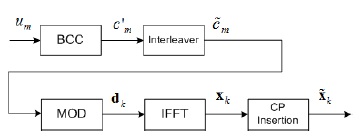- ALL COMPUTER, ELECTRONICS AND MECHANICAL COURSES AVAILABLE…. PROJECT GUIDANCE SINCE 2004. FOR FURTHER DETAILS CALL 9443117328


Projects > ELECTRONICS > 2017 > IEEE > COMMUNICATION
In this paper, a delay diversity OFDM (DD OFDM) transmission scheme in amplify-and-forward (AF) full-duplex relay systems is investigated. One direct source-to-destination link, one relay forwarding link and residual self-interference (RSI) are considered in the system. The necessary cyclic prefix (CP) length is investigated and a suitable AF relay protocol in the full-duplex relay OFDM system is proposed. This paper demonstrates that the AF relay link and the direct source-to-destination link can be combined to provide spatial diversity. The key is that the DD OFDM scheme is used to transform the spatial diversity into increased channel frequency diversity that is further exploited by using the bit interleaved coding. The BER performance of the proposed system is verified by simulation results.
Diversity-Multiplexing, Linear Convolutional Space-Time Coding.
In this paper, one DD OFDM scheme in full-duplex relay communication systems with one source node, one relay node, and one destination node is considered. Firstly, we carry forward the idea of utilizing residual SI as useful signal rather than noise. The direct link coefficient, relay link coefficient and the residual SI are altogether modeled as a virtual multipath channel at the destination, which is a novel idea for the full-duplex OFDM relay system and facilitates fully utilizing the residual SI as a beneficial signal component. Based on our proposed system model, the necessary CP length at the source node is discussed. Generally, if more residual SI is modeled as the virtual multipaths at the destination, a more extended CP is required and thus less interference is introduced to the proposed system. Next, we also propose a block-based AF relay protocol to realize the DD OFDM at the destination node. With the help of this protocol, the full-duplex relay link can act as an extra diversity branch to provide enhanced robustness to our proposed full-duplex relay system. In addition, we utilize bit-interleaved coded modulation (BICM) OFDM to collect the diversity order of two in the AF relay system. Simulation results show the effectiveness of our proposed scheme. Finally, we also discuss the power allocation problem for our proposed full-duplex relay communication system with a total sum power constraint on the source and relay transmission powers. Simulation results demonstrate that the proposed power allocation performs better than equal power allocation.
Source node signal processing diagram
